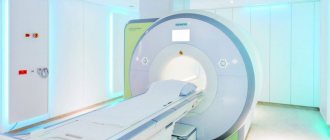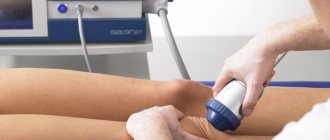Duration of the examination: 25-35 minutes. Administration of contrast: according to indications. Preparation for the examination: not required. Contraindications: yes. Restrictions: weight over 130 kg. For the clinic on Simferopolsky Blvd. weight more than 180 kg. Preparation of the conclusion: 2 hours.
MRI (magnetic resonance imaging) of joints is the most effective and accurate method for examining all elements and tissues of articular joints. The uniqueness of the procedure lies in obtaining a detailed image of various structures both inside and outside the joint (ligaments, tendons, cartilage, adipose tissue, bone marrow, blood vessels, etc.).
MRI of joints at SM-Clinic is an opportunity to visualize tissues in various planes with the required approximation for the most accurate diagnosis of diseases and assessment of pathological processes over time.
Advantages of MRI of joints at SM-Clinic
At SM-Clinic, MRI of joints is performed using high-tech equipment in the most comfortable conditions for the patient. The combination of advanced technologies with the experience of our diagnosticians guarantees the utmost accuracy and information content of the study. MRI of joints in our center is an absolutely safe procedure, since X-rays are not used. Magnetic resonance imaging of joints at the SM-Clinic is an examination without long waits and queues at a time that suits you.
Contraindications for MRI of ENT organs
Despite the fact that magnetic resonance imaging shows high efficiency, there are some contraindications when using it for diagnosis. This limits the scope of application of this diagnostic method.
- Pregnant women, especially in the first trimester, are contraindicated to undergo MRI.
- If a woman is breastfeeding, this also imposes restrictions on the use of MRI.
- The presence of foreign bodies in the body that contain metals (pins, implants, pacemakers, bullets, shell fragments, etc.) can not only damage the device, but also have negative consequences on the body.
- Those suffering from claustrophobia are not recommended to undergo an MRI, as they will have to be in a special closed “capsule” for a long time without the ability to move.
- When performing an MRI with a contrast agent, you need to pay attention to whether the person being examined has kidney problems. If they are present, the procedure is contraindicated.
If we compare CT and MRI, the latter method is more expensive, so it is used only in cases where it is impossible to diagnose the disease by other methods.
Why do an MRI of joints?
Magnetic resonance imaging of joints provides extremely accurate diagnosis of pathologies of various kinds in structures and tissues. In many cases, MRI using modern SM-Clinic equipment allows you to avoid complex invasive examinations, including punctures (punctures of the joint) and additional radiography.
Of particular importance is the ability to diagnose using MRI at the earliest stages:
- inflammation in the joint system;
- pathological processes inside the bone (for example, with gout);
- tumors and other neoplasms (with determination of their nature);
- degenerative changes in joints.
MRI of joints at SM-Clinic is successfully used to accurately assess traumatic injuries, monitor the progress of treatment and prepare for joint surgery.
Moreover, we can offer you MRI of joints with contrast (for precise localization of tumors, in case of ambiguous symptoms and conflicting results of other examinations).
What is MRI?
To understand how MRI and tattoos are related in general, you need to understand what this examination is. Magnetic resonance imaging is a method of obtaining images of the internal areas of the human body, which are subsequently used to diagnose various diseases of the internal organs.
The tomograph allows radiofrequency pulses and a powerful magnetic field to make “slices” (as images of internal areas of the body are called). The device sends signals to the human body, and after a certain period of time, receives them already reflected from the tissues. In turn, the computer, having received such modified signals, converts them into 3D images.
The magnetic force of the device is so great that metal objects located in the room during the examination will heat up. This may result in personal injury and equipment damage. Even if they are small metal particles, the resulting image may be distorted.
Make an appointment now!
Is magnetic resonance imaging of the pelvis safe?
MRI is absolutely harmless for any category of patients. The exception is pregnant women: during this period it is better to refuse to conduct a study with contrast, and in the first trimester - to refrain from MRI at all.
Equipment for magnetic resonance imaging
Magnetom Aera MRI scanner (1.5 Tesla)
- Expert level research
- Exceptionally high image quality
- Comfortable conditions for patients with limited mobility
- Maximum patient weight: 180 kg
MRI scanner Siemens Magnetom Essenza (1.5 Tesla)
- New generation tomograph
- High image quality and data accuracy
- Suitable for patients with claustrophobia
- Maximum patient weight: 130 kg
Relative contraindications
Relative contraindications are those diseases or conditions that could theoretically cause a deterioration in the patient’s well-being during the examination.
These include:
- the use of metal-containing inks for tattoos (a burn may occur on the skin at the tattoo site);
- the patient’s inability to remain motionless (severe pain, severe conditions, mental disorders);
- claustrophobia (fear of closed spaces);
- state of pregnancy or breastfeeding;
- young children (it is difficult for children to lie quietly on their own);
- body weight of the subject over 120 kg (for examinations in closed-type tomographs).
The decision in which cases a patient with relative contraindications can be examined is made by the MRI diagnostic physician. In order for his decision to be objective, the patient must take with him all the medical documents he has (cards, extracts, results of previous studies).
The issue of banning MRI examinations during pregnancy remains open today. There is no reliable evidence that the magnetic field has a detrimental effect on the fetus or the course of pregnancy itself, and there is no confirmation that it does not cause harm.
Doctors believe that if a woman has good reasons for conducting a study (suspicion of a tumor, acute conditions or a threat to life), then such a contraindication as pregnancy is not absolute. For which diseases MRI is justified for a pregnant woman to undergo, her attending physician decides in consultation with the gynecologist managing the pregnancy. If necessary, during pregnancy, preference is given to magnetic resonance imaging without contrast, and if possible, then in the second or third trimester.
Why can’t you do an MRI with contrast during pregnancy? The fact is that clinical trials of the effect of paramagnetic agents (gadolinium contrast agents) on the condition of the fetus have not been conducted, so there is no data on their safety. To protect the fetus from the possible teratogenic effect of gadolinium, contrast should be avoided during the MR procedure.
Contraindications to MRI of joints
There are few contraindications to MRI. These include the presence in the body of metal-containing objects (shards, pacemakers, electromechanical implants, etc.), which can become magnetized and overheat during the procedure, as well as the presence of tattoos inked with metal particles.
Limitations for MRI of joints (discussed separately):
- for a clinic on the street. Clara Zetkin - maximum weight 120 kg, maximum circumference more than 140 cm;
- for the clinic on Volgogradsky Prospekt - maximum weight 120 kg, maximum circumference 120 cm;
- for the clinic on Yaroslavskaya street - maximum patient weight 200 kg, maximum body circumference in the largest dimension 140 cm;
- for a clinic on Simferopol Boulevard - maximum weight 180 kg, provided that the maximum body circumference in the largest dimension is no more than 130 cm, if the circumference is less than 130 cm, then the maximum weight is 200 kg;
- claustrophobia;
- reasons that prevent you from remaining still during the procedure (30-40 minutes);
MRI with contrast is not recommended during pregnancy, breastfeeding, or kidney disease. At SM-Clinic, you can get a specialist consultation at a time convenient for you, which is necessary to clarify contraindications and restrictions.
Can I get an MRI with a tattoo?
“So what does the tattoo have to do with it?” - you ask. And despite the fact that previously some masters made them using ink that contained small metal enzymes. But such ink was used more than 20 years ago.
In addition, there is evidence that some patients with tattoos have complained of discomfort during MRI examinations. Judging by such data, experts concluded that the magnetic fields of the devices pull metal particles with such force that they cause a burning sensation in humans.
Thus, the answer to the question whether it is possible to do magnetic resonance imaging with a tattoo should be positive for the following reasons:
- Modern dyes used by tattoo artists do not contain metal.
- If the tattoo is old, it does not necessarily contain metal.
- Even if there are metal particles in the tattoo, this is not always a contraindication for examination.
However, if you have a tattoo on your body, tell your doctor about it before getting an MRI. An experienced specialist will help identify the level of likelihood of discomfort during diagnosis.
Preparation for MRI of joints
An MRI of the knee joint, like an MRI of the shoulder and hip joints, can be done without any preparation. Enough before the procedure:
- refuse decorative cosmetics (there may be metal particles);
- remove all metal objects;
- exclude irritating factors that can prevent you from lying still (go to the toilet, if you are undergoing drug therapy, take medications, etc.).
It is advisable to present the diagnostician with data from previous studies and test results. At SM-Clinic you can have a completely free consultation by phone
for preparing for MRI of joints at any time of the day.
MRI and metal plates
All metals are divided into three large groups depending on how they react to the influence of a magnetic field. Dia- and paramagnets are subject to little influence of the field, in contrast, ferromagnets are highly susceptible to its action.
The plates are made on the basis of steel, which is ferromagnetic, and titanium (paramagnetic). Is it possible to do MRI with titanium plates? If there are titanium plates in the leg, spine or upper limbs, scanning can be done, because they will neither warm up nor move.
Plates made of steel can become very hot in a magnetic field, and the degree of heating directly depends on their length. It is believed that heating plates longer than 20 cm is dangerous, however, even in this case, the doctor may allow you to do an MRI with a steel wire or pin. In this case, the study is carried out until the patient feels heat in the place where the steel object is installed - then the diagnosis stops.
How is an MRI of joints performed?
MRI of joints at SM-Clinic is an extremely comfortable procedure.
You just need to lie motionless inside the tomograph capsule, which is well lit, has ventilation and equipment for two-way communication with the diagnostician.
For your peace of mind and to obtain the clearest image possible, your arms and legs are additionally fixed.
If necessary, contrast is administered intravenously before the procedure.
MRI of joints at SM-Clinic is a guarantee of your comfort, safety and 100% results, thanks to the technological equipment and practical experience of our diagnosticians.
Is it possible to do an MRI with a titanium plate?
Magnetic resonance imaging involves exposing the body to a magnetic field and recording the response of hydrogen atoms to it in water molecules in cells. A computer program processes the information recorded by the sensors and then converts it into a highly accurate image of internal structures. Based on the images, the doctor diagnoses the disease.
Implants can be made from different materials. Depending on the reaction of the metal to a magnetic field, there are:
- Diamagnets (bismuth, copper, etc.) - distort diagnostic results due to the induced magnetic moment;
- paramagnetic materials (titanium, platinum, aluminum, tungsten, etc.; non-metallic materials) - practically do not interact with the field created by the MRI scanner;
- ferromagnets (iron, cobalt, chromium, nickel) - capable of heating and moving.
According to the requirements for materials for implants approved in the Russian Federation, they must:
- get certified;
- be bioinert;
- predominantly composed of non-magnetic materials.
Titanium is paramagnetic, which means it is recognized as MRI-compatible. Before the examination, the radiologist must read the document describing the implant. The patient receives a certificate upon discharge from the medical institution where the plate was installed. The documents indicate the nature of the material and a description of the implant: its shape, size, location, method of attachment, etc.
The presence of a plate in the head is not a contraindication for MRI of all other parts of the body (if it is proven that it is titanium or made of another paramagnetic material). If it is necessary to examine the brain, facial structures and neck, the doctor assesses the situation individually, taking into account the size and position of the metal element.










